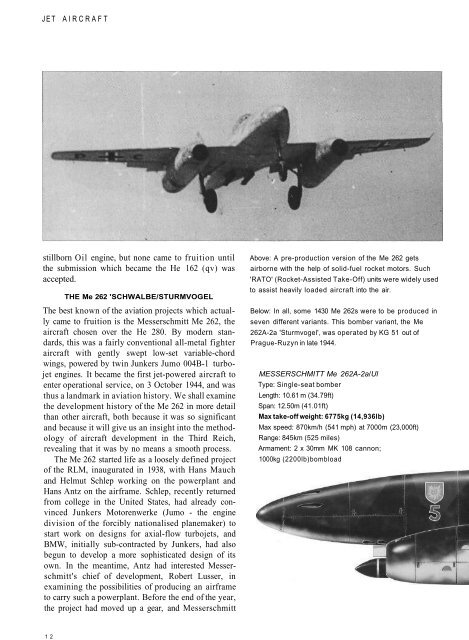Submarines and their Weapons - Aircraft of World War II
Submarines and their Weapons - Aircraft of World War II
Submarines and their Weapons - Aircraft of World War II
Create successful ePaper yourself
Turn your PDF publications into a flip-book with our unique Google optimized e-Paper software.
JET AIRCRAFT<br />
stillborn Oil engine, but none came to fruition until<br />
the submission which became the He 162 (qv) was<br />
accepted.<br />
THE Me 262 'SCHWALBE/STURMVOGEL<br />
The best known <strong>of</strong> the aviation projects which actually<br />
came to fruition is the Messerschmitt Me 262, the<br />
aircraft chosen over the He 280. By modern st<strong>and</strong>ards,<br />
this was a fairly conventional all-metal fighter<br />
aircraft with gently swept low-set variable-chord<br />
wings, powered by twin Junkers Jumo 004B-1 turbojet<br />
engines. It became the first jet-powered aircraft to<br />
enter operational service, on 3 October 1944, <strong>and</strong> was<br />
thus a l<strong>and</strong>mark in aviation history. We shall examine<br />
the development history <strong>of</strong> the Me 262 in more detail<br />
than other aircraft, both because it was so significant<br />
<strong>and</strong> because it will give us an insight into the methodology<br />
<strong>of</strong> aircraft development in the Third Reich,<br />
revealing that it was by no means a smooth process.<br />
The Me 262 started life as a loosely defined project<br />
<strong>of</strong> the RLM, inaugurated in 1938, with Hans Mauch<br />
<strong>and</strong> Helmut Schlep working on the powerplant <strong>and</strong><br />
Hans Antz on the airframe. Schlep, recently returned<br />
from college in the United States, had already convinced<br />
Junkers Motorenwerke (Jumo - the engine<br />
division <strong>of</strong> the forcibly nationalised planemaker) to<br />
start work on designs for axial-flow turbojets, <strong>and</strong><br />
BMW, initially sub-contracted by Junkers, had also<br />
begun to develop a more sophisticated design <strong>of</strong> its<br />
own. In the meantime, Antz had interested Messerschmitt's<br />
chief <strong>of</strong> development, Robert Lusser, in<br />
examining the possibilities <strong>of</strong> producing an airframe<br />
to carry such a powerplant. Before the end <strong>of</strong> the year,<br />
the project had moved up a gear, <strong>and</strong> Messerschmitt<br />
1 2<br />
Above: A pre-production version <strong>of</strong> the Me 262 gets<br />
airborne with the help <strong>of</strong> solid-fuel rocket motors. Such<br />
'RATO' (Rocket-Assisted Take-Off) units were widely used<br />
to assist heavily loaded aircraft into the air.<br />
Below: In all, some 1430 Me 262s were to be produced in<br />
seven different variants. This bomber variant, the Me<br />
262A-2a 'Sturmvogel', was operated by KG 51 out <strong>of</strong><br />
Prague-Ruzyn in late 1944.<br />
MESSERSCHMITT Me 262A-2a/Ul<br />
Type: Single-seat bomber<br />
Length: 10.61 m (34.79ft)<br />
Span: 12.50m (41.01ft)<br />
Max take-<strong>of</strong>f weight: 6775kg (14,936lb)<br />
Max speed: 870km/h (541 mph) at 7000m (23,000ft)<br />
Range: 845km (525 miles)<br />
Armament: 2 x 30mm MK 108 cannon;<br />
1000kg (2200lb)bombload


